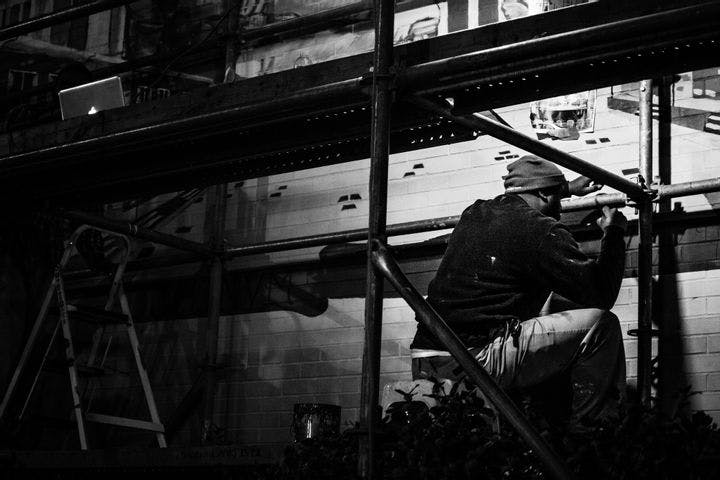Liturgical designers’ challenge: balancing tradition with creativity
– Erin Amato
Just because you can pick your altar out of a catalog doesn't mean that you should.
Liturgical designers Lawrence Hoy and Robert Rambusch stroll slowly through New York City’s Church of the Holy Family as they revisit an interior they created together in the post-Vatican II reformed liturgical style. Hoy, 58, finally reunites with his 90-year-old mentor as they study a tabernacle enclosure reminiscent of the Church of the Nativity in Bethlehem.
“How about adding the 12 apostles, six on each side?” proposes a tourist, offering a suggestion to fill the bare wall alongside a towering statue of the Risen Christ. Both designers bristle at her suggestion: Hoy prefers a minimalist approach. Many parishioners offer unsolicited advice, yet the task of the designer is to bridge the awe of the eternal with the reverence for specific religious traditions.
50 years ago, the Vatican II council substantially changed the Catholic Church, altering not only the language used in worship (Ite, missa est to the Latin mass, Hola to the congregation’s local tongue), but by actively constructing the Church in something of a more populist manner. Commonweal contributor Bethe Dufresne writes of some of the most tangible changes: clergy were encouraged to seek and support participation of the laity, and new churches would would do away with the long runway of a center aisle flanked by row after row of worshippers—the distant, gothic feel replaced instead by a more accessible design somewhat akin to a church “in the round.”
Lawrence Hoy and Peter Scurlock co-own Renovata Studios, a Port Chester, New York-based firm specializing in liturgical architecture. The two designers’ work includes such high-profile projects as the renovation of the altar for the 1996 Central Park Mass by Pope John Paul II, and the fashioning of the papal throne for Pope Benedict XVI at Ground Zero, Yankee Stadium, and St. Joseph’s Seminary. Good design, says Hoy, “really transforms the space into something that’s so much more than a ‘Sunday only’ worship service.”
Fresh out of college, Hoy became an assistant to Robert Rambusch, a top liturgical designer unafraid to embrace minimalism while designing cathedrals. After branching out on his own, Hoy founded Renovata, mixing his love for architecture and his fascination with Catholicism. He gained a name for himself — exquisite designs, never over-budget, scrupulously avoiding tacky faux stonework. Clients such as Cardinal John O’Connor rave over Hoy’s attention to transformative design and his reverence for historic preservation. Even so, he says he’s not going to practice Catholicism “just because that’s how I’m making my money.”
Hoy is most consulted by Catholic Churches seeking to repair peeling paint or leaking baptismal fonts. Yet some major renovations come out of routine repairs: for St. Luke’s Church in Queens, New York, Monsignor Jon Tosi awarded Hoy artistic license to “enhance the liturgical space.”
Dufresne relates how Hoy makes it look easy: he blends the ornate grandeur of centuries long ago with the newness of post-modernism. Hoy is “creative, yet he has an appreciation for what’s already there,” praises Monsignor Tosi. “He can honor history while bringing it up-to-date with the times.”
Tosi’s church — half-1898 brick English Gothic, half-20th century “Country Gothic” — is a nightmare for architects hell-bent on authenticity. Not so for Hoy: he copied Gothic moldings to remedy this “stylistic dissonance.” His additional renovations brought the sanctuary closer to the middle of the church. Afterwards, Hoy moved the tabernacle — a fixed storage for the Communion — to its former place in the semicircular vault called the apse. In doing so, Hoy brought parishioners closer to the altar and closer to God.
Dufresne notes that Vatican II encouraged better sightlines in church to make parishioners feel included. Architects agree that a church should honor God while connecting congregations in its accessibility, but liturgical designers disagree over the best way to achieve that result. Though Rambusch embraces openness, critics including Duncan G. Stroik, professor of architecture at University of Notre Dame, have a different approach. “Sometimes the simple became simplistic,” Stroik contends, comparing modernist churches with bland functionality to high school gymnasiums. He decries the reduction of human figures, especially in Catholic Churches where the body of Christ is essential.
Both Stroik and Hoy believe a church should not remind people of Disney’s Epcot. Recently, newer Southern Catholic Churches have embraced traditional décor, yet such a trend need not be gauche. Hoy incorporates some contemporary architecture with tradition, helping clients ‘find themselves’ in their church.
In light of the clash between traditional and modern, Hoy isn’t afraid to challenge the Vatican II conception of architecture to bring about the best result for his clients. He jokes that many practically “lie down before the scaffolding equipment” to avoid changes to their church. Once he redesigns the church, however, clients are stunned: “now your design is the one that they’re going to lie down in front of the bulldozers for.”
The Source: “A Sermon in Stone” by Bethe Dufresne. Commonweal Magazine, June 1, 2014.
Photo courtesy of Flickr/The Q Speaks
